Thursday, August 31st 2017

Intel Announces Xeon-W Workstation CPUs - Skylake-SP and ECC Memory
In a response to AMD's current uptake in the consumer, HEDT and server markets with its vertical slice of the Zen architecture, Intel has started rebranding their products and image, changing product names and placement in a bid to increase the "freshness" factor of its offerings. E5 and E7 Xeons are gone, with the introduction of a metallic naming scheme: Bronze, Silver, Gold and Platinum are now Intel's Xeon products, and Xeon-W takes the spot as Intel's workstation-oriented product stack. They do this by being - essentially - a conversion of Intel's Core i9 X299 family of processors towards the professional market with inclusion of professional-geared features. And as is usual with Intel, a new chipset - C422 - is needed in order for these to properly function.
The new Xeon-W product family will still make use of the LGA 2066 socket, bringing with them ECC and vPro support. The Xeon-W CPU family will feature 4 to 18 cores, support up to 512GB of ECC RDIMM/LRDIMM memory, support dual 512-bit FMAs, and peak clocks of 4 GHz base and 4.5 GHz Turbo. All the parts will support 48 PCIe 3.0 lanes from the processor,and CPUs in the Xeon-W stack are rated at 140W TDP: with exception of the quad cores, which come in at at 120W. Xeon-W processors only support Turbo Boost 2.0, instead of their Core i9 counterparts' Turbo 3.0.Intel's 14 and 18-core CPUs won't be available at the platform's launch, and are instead being planned for a Q4 roll-out - the same as Intel's Core i9 platform. However, comparing Intel's Xeon-W and AMD's Ryzen Threadripper And EPYC processors proves to be an interesting dilemma in features and pricing. Or maybe not so:As you can see, Intel's Xeon W-2145 features the same amount of cores and threads as AMD's Threadripper 1900X, and has a lesser amount of PCIe lanes available from the CPU, down to 48 from Intel's option compared to the 1900X's 60 lanes. AMD's 1900X also ships with a higher base frequency, and a larger amount of cache, though these likely aren't enough to counter Intel's pure per-core IPC - especially when it comes to AVX workloads, where Intel's dual 512-bit FMAs/AVX-512 support should deliver extremely convincing performance against the ThreadRipper 1900X. AMD's platform also has support for lesser amounts of DDR4 memory, which is a point to consider for some workloads (though Intel isn't supporting 128 GB RAM modules in the W-series processors.)
Whether or not the extra PCIe lanes will offset the RAM amount limitation depends on the particular use cases. though one thing doesn't depend on use case: the amount of money spent. Here, we see that AMD's 8 core/16 thread 1900X costs less than half of what its Intel counterpart does - it's certainly an interesting fight in features/pricing /performance.
Consider AMD's price-equivalent EPYC 7401P offering, though, and Intel's W-2145 looks... Well, it costs more; delivers 1/3 the amount of CPU cores and threads; delivers less than half the amount of PCIe lanes; supports only 512 GB memory, or 1/4 of what the EPYC chip does, in a 4-channel configuration instead of an 8-channel one; and is rated at only 15-20 W less than the EPYC 7401P. Now granted, AMD's chip does run at a much lesser 2.0/3.0 GHz base and boost clocks compared to the W-2145's respective 3.7/4.5 GHz frequencies, but... At least in multi-threaded workloads, there is no competition possible here.
As to retail availability, the up to 10-core parts are available from OEMs from August 29th. However, only the W-2123 and W-2135 are going to be available in official retail packaging, with end-users having to procure the other parts through non-retail sources.
Source:
AnandTech
The new Xeon-W product family will still make use of the LGA 2066 socket, bringing with them ECC and vPro support. The Xeon-W CPU family will feature 4 to 18 cores, support up to 512GB of ECC RDIMM/LRDIMM memory, support dual 512-bit FMAs, and peak clocks of 4 GHz base and 4.5 GHz Turbo. All the parts will support 48 PCIe 3.0 lanes from the processor,and CPUs in the Xeon-W stack are rated at 140W TDP: with exception of the quad cores, which come in at at 120W. Xeon-W processors only support Turbo Boost 2.0, instead of their Core i9 counterparts' Turbo 3.0.Intel's 14 and 18-core CPUs won't be available at the platform's launch, and are instead being planned for a Q4 roll-out - the same as Intel's Core i9 platform. However, comparing Intel's Xeon-W and AMD's Ryzen Threadripper And EPYC processors proves to be an interesting dilemma in features and pricing. Or maybe not so:As you can see, Intel's Xeon W-2145 features the same amount of cores and threads as AMD's Threadripper 1900X, and has a lesser amount of PCIe lanes available from the CPU, down to 48 from Intel's option compared to the 1900X's 60 lanes. AMD's 1900X also ships with a higher base frequency, and a larger amount of cache, though these likely aren't enough to counter Intel's pure per-core IPC - especially when it comes to AVX workloads, where Intel's dual 512-bit FMAs/AVX-512 support should deliver extremely convincing performance against the ThreadRipper 1900X. AMD's platform also has support for lesser amounts of DDR4 memory, which is a point to consider for some workloads (though Intel isn't supporting 128 GB RAM modules in the W-series processors.)
Whether or not the extra PCIe lanes will offset the RAM amount limitation depends on the particular use cases. though one thing doesn't depend on use case: the amount of money spent. Here, we see that AMD's 8 core/16 thread 1900X costs less than half of what its Intel counterpart does - it's certainly an interesting fight in features/pricing /performance.
Consider AMD's price-equivalent EPYC 7401P offering, though, and Intel's W-2145 looks... Well, it costs more; delivers 1/3 the amount of CPU cores and threads; delivers less than half the amount of PCIe lanes; supports only 512 GB memory, or 1/4 of what the EPYC chip does, in a 4-channel configuration instead of an 8-channel one; and is rated at only 15-20 W less than the EPYC 7401P. Now granted, AMD's chip does run at a much lesser 2.0/3.0 GHz base and boost clocks compared to the W-2145's respective 3.7/4.5 GHz frequencies, but... At least in multi-threaded workloads, there is no competition possible here.
As to retail availability, the up to 10-core parts are available from OEMs from August 29th. However, only the W-2123 and W-2135 are going to be available in official retail packaging, with end-users having to procure the other parts through non-retail sources.
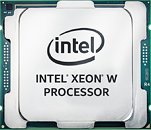
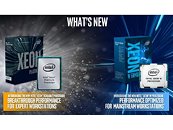
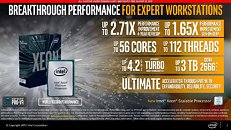
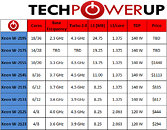
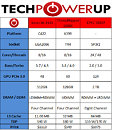

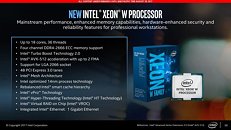
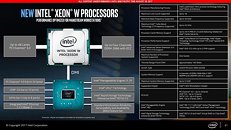



6 Comments on Intel Announces Xeon-W Workstation CPUs - Skylake-SP and ECC Memory
if 8cores cost on blue team 800 much they ask for 56 cores? lol
BTW, I wonder how many who bought Ryzen in part due to "more PCIe lanes" will actually have more than two GPUs with a heavy compute workload?